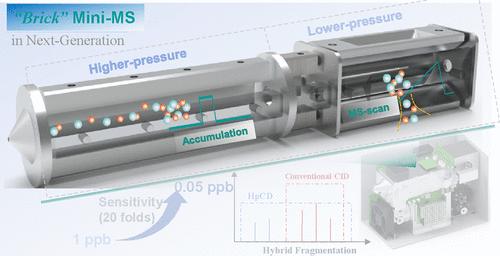具有增强灵敏度和破碎能力的双阱“砖”微型质谱仪
IF 6.7
1区 化学
Q1 CHEMISTRY, ANALYTICAL
引用次数: 0
摘要
虽然由于尺寸和功率的限制,质谱(MS)的小型化经常影响分析性能,但复杂样品的直接现场分析需要微型质谱仪(mini-MS)来增强仪器功能。为了解决这一挑战,我们将“Brick”mini-MS开发为下一代系统,该系统采用了双差压阀配置。每个陷阱在不同的压力下工作,实现并行和优化的操作:在较高的压力下离子积累/冷却和解离,结合在较低的压力下离子分离和质谱分析。两个陷阱之间的高效离子转移使平行离子操作和不同的碎片模式成为可能。平行离子积累模式将微型仪器的灵敏度提高了约20倍,降至50 pg/mL。除了常规的阱内碰撞诱导解离(CID)外,还研究了离子加速和穿梭过程中的转移解离以及高压阱中的高压碰撞解离(HpCD)。结果表明,HpCD可以产生更广泛的离子碎片,这是在束型碰撞激活解离方法中通常观察到的。这项研究显著提高了mini-MS在高性能、可现场部署分析应用方面的能力。本文章由计算机程序翻译,如有差异,请以英文原文为准。

Dual-Trap “Brick” Miniature Mass Spectrometer with Enhanced Sensitivity and Fragmentation Capabilities
Although the miniaturization of mass spectrometry (MS) frequently compromises analytical performance due to size and power limitations, the direct on-site analysis of complex samples requires a miniature mass spectrometer (mini-MS) to have enhanced instrument capabilities. To resolve this challenge, we have developed our “Brick” mini-MS into a next-generation system incorporating a differential-pressure dual-trap configuration. Each trap functions at distinct pressures, enabling parallel and optimized operations: ion accumulation/cooling and dissociation at higher pressures, in conjunction with ion isolation and MS analysis at lower pressure. Efficient ion transfer between the two traps enables parallel ion manipulation and diverse fragmentation modes. The parallel ion accumulation mode boosted the sensitivity of the miniature instrument by ∼20-fold, down to 50 pg/mL. In addition to conventional in-trap collision induced dissociation (CID), transfer dissociation during the ion accelerating and shuttling process and high-pressure collisional dissociation (HpCD) in a higher-pressure trap were also investigated. The results demonstrate that HpCD can generate more extensive ion fragments, which are typically observed in beam-type collisional activation dissociation methods. This study significantly advances the capabilities of mini-MS for high-performance, field-deployable analytical applications.
求助全文
通过发布文献求助,成功后即可免费获取论文全文。
去求助
来源期刊

Analytical Chemistry
化学-分析化学
CiteScore
12.10
自引率
12.20%
发文量
1949
审稿时长
1.4 months
期刊介绍:
Analytical Chemistry, a peer-reviewed research journal, focuses on disseminating new and original knowledge across all branches of analytical chemistry. Fundamental articles may explore general principles of chemical measurement science and need not directly address existing or potential analytical methodology. They can be entirely theoretical or report experimental results. Contributions may cover various phases of analytical operations, including sampling, bioanalysis, electrochemistry, mass spectrometry, microscale and nanoscale systems, environmental analysis, separations, spectroscopy, chemical reactions and selectivity, instrumentation, imaging, surface analysis, and data processing. Papers discussing known analytical methods should present a significant, original application of the method, a notable improvement, or results on an important analyte.
 求助内容:
求助内容: 应助结果提醒方式:
应助结果提醒方式:


